Creating a Super Garden With SPV Soils Raised Garden Bed Mix

by Craig Kolodge Ph.D. (aka Dr. K)
Creating a Super Garden with SPV Soils Raised Garden Bed Mix is easy to do when you follow Dr. K’s steps below.
Locating the Super Garden
When planning a new garden, keep in mind that vegetable crops must have at least 8 hours of direct sun each day and should be planted where the soil drains well.
Preparing Your Raised Garden Bed
When building a raised bed garden, don’t skimp on the soil. Use a minimum of 12 inches of San Pasqual Valley Soils’ Raised Garden Bed Mix which has been specially formulated to provide an optimal ratio of water, air and composted materials containing slow release nutrients for plant development.
The best way to get your plants off to a great start is by adding a supplemental source of nitrogen fertilizer at the time of planting. See below suggestions on how to do this.
Adding fertilizer – two options:
Synthetic N (fast-acting)
Apply 1 pound of ammonium sulfate (21- 0-0) per 100 square feet (10 feet by 10 feet) and thoroughly mix into top 3 inches of soil before planting. Then sprinkle 1 tablespoon of ammonium sulfate around each plant every 3 weeks and water it in. Do not add too much ammonium sulfate, and do not put it too close to the plants as It can seriously damage them. This fertilizer is also an excellent source of sulfur (24%), an important essential element for optimum plant development.
Organic N (slow release)
Or, apply 3 to 4 pounds of an organic slow-release fertilizer like feather meal (12-0-0) per 100 square feet of garden bed area and thoroughly mix into the top 3 inches of soil. incorporate 2 tablespoon of feather meal around each plant every 3 weeks and water it in. You can also apply a compost tea drench at the time of fertilizing with the feather meal.
After incorporating your choice of fertilizer, prepare garden beds for planting based on the type and mature size of the vegetable plant and whether you are direct seeding or transplanting seedlings. Raised garden beds are typically 4 to 5 ft wide allowing you to move easily around the gardening area for easy access for planting, maintaining and harvesting your crops from both sides of the bed.
Prior to planting, water the entire raised garden bed soil with a gentle hose-end nozzle until it is thoroughly saturated and allow the bed surface to dry for a day or two before planting.
Planting
Because of the higher quality of SPV Soils Raised Garden Bed Mix, you can typically space your seeds or transplants closer in a grid-like pattern rather than the row spacing that is recommended on seed packets. Experience will teach you what the best plant spacings and pattern is depending on what you are growing.
Plants generally do better in a raised garden bed system when started from transplants rather than from seed. Tomatoes and peppers are typically grown using transplants.
The trick to establishing healthy transplants during hot weather is to make sure they have plenty of water. Transplants in peat pots or cell packs using a quality seed-starting mix, develop restricted roots that require approximately 2 weeks to develop. During this early phase of seedling growth they may need to be watered every day to prevent stunting or even death of the seedlings.
Because of the high amount of organic compost in the SPV Soils Raised Garden Bed Mix, it is typically not necessary to water daily two weeks following transplanting. A thorough watering every 3 days is usually sufficient depending on the temperature and weather conditions. Do not apply water if the soil surface appears moist or damp to the touch. Too much water can be as detrimental to plant development as too little.
That’s it … follow these simple guidelines and you will be very pleased with the results and be able to lay claim to the title of “San Pasqual Valley Soils Green Thumb Gardener!” Enjoy and Happy Gardening!
.
SPVSoils Raised Garden Bed Mix User Guide pdf
Creating a Super Garden with SPV Soils Raised Garden Bed Mix pdf
Portions of this guideline were taken from the Texas A&M AgriLife Extension Service Online Garden Resource entitled: “Fall Vegetable Gardening Guide for Texas” Larry Stein and Joe Masabni – October 2019
